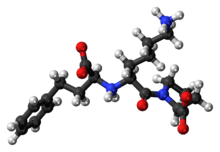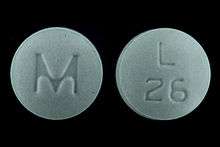Lisinopril
 | |
 Chemical structure of lisinopril | |
| Systematic (IUPAC) name | |
|---|---|
|
(2S)-1-[(2S)-6-amino-2-[[(1S)-1-carboxy-3-phenylpropyl]amino]hexanoyl]pyrrolidine-2-carboxylic acid | |
| Clinical data | |
| Pronunciation | /laɪˈsɪnəprɪl/, ly-SIN-ə-pril |
| Trade names | Prinivil, Tensopril, Zestril, Hipril |
| AHFS/Drugs.com | monograph |
| MedlinePlus | a692051 |
| Pregnancy category |
|
| Legal status |
|
| Routes of administration | Oral |
| Pharmacokinetic data | |
| Bioavailability | approx. 25%, but wide range between individuals (6 to 60%) |
| Protein binding | 0 |
| Metabolism | None |
| Biological half-life | 12 hours |
| Excretion | Eliminated unchanged in urine |
| Identifiers | |
| CAS Number | 83915-83-7 |
| ATC code | C09AA03 |
| PubChem | CID 5362119 |
| IUPHAR/BPS | 6360 |
| DrugBank |
APRD00560 |
| ChemSpider |
4514933 |
| UNII |
7Q3P4BS2FD |
| KEGG |
D00362 |
| ChEBI |
CHEBI:43755 |
| ChEMBL |
CHEMBL1237 |
| Synonyms | (2S)-1-[(2S)-6-amino-2-{[(1S)-1-carboxy-3-phenylpropyl]amino}hexanoyl]pyrrolidine-2-carboxylic acid |
| PDB ligand ID | LPR (PDBe, RCSB PDB) |
| Chemical data | |
| Formula | C21H31N3O5 |
| Molar mass | 405.488 g/mol |
| |
| |
| | |
Lisinopril is a drug of the angiotensin-converting enzyme (ACE) inhibitor class used primarily in treatment of high blood pressure, heart failure, and after heart attacks. It is also used for preventing kidney and eye complications in people with diabetes. Its indications, contraindications, and side effects are as those for all ACE inhibitors.
Lisinopril was the third ACE inhibitor (after captopril and enalapril) and was introduced into therapy in the early 1990s.[2] A number of properties distinguish it from other ACE inhibitors: It is hydrophilic, has a long half-life and tissue penetration, and is not metabolized by the liver.
Medical uses
Lisinopril is typically used for the treatment of hypertension, congestive heart failure, acute myocardial infarction, and diabetic nephropathy.[3]
It received FDA approval on May 19, 1988.[4]
Contraindications
Treatment with lisinopril should be avoided in the following situations:
- History of angioedema (hereditary or idiopathic)[5]
- Hypersensitivity reaction to lisinopril or any of other components found in its formulation[5]
- Concomitant use of aliskiren-containing drugs in patients with diabetes[5]
Combination of aliskiren and lisinopril is contraindicated in patients with diabetes, and should be avoided in those with creatinine clearance less than 60ml/min. This combination may heighten the hyperkalemic, hypotensive, and nephrotoxic effects of lisinopril (and other ACE inhibitors). Therefore, serum potassium, blood pressure, and serum creatinine should be carefully monitored for all patients on this combination.

Adverse effects
Side effects, incidence differs depending on which disease state the patient is being treated for.[1]
People taking lisinopril for the treatment of hypertension may experience the following side effects:
- Headache (3.8%)
- Dizziness (3.5%)
- Cough (2.5%)
- Difficulty swallowing or breathing (signs of angioedema), allergic reaction (anaphylaxis)
- Hyperkalemia (2.2% in adult clinical trials)
- Fatigue (1% or more)
- Diarrhea (1% or more)
- Stevens-Johnson syndrome (1% or more)
People taking lisinopril for the treatment of acute myocardial infarction may experience the following side effects:
- Hypotension (5.3%)
- Renal dysfunction (1.3%)
People taking lisinopril for the treatment of heart failure may experience the following side effects:
- Hypotension (3.8%)
- Dizziness (12-19%)
- Chest pain (2.1%)
- Fainting (5-7%)
- Hyperkalemia (4.8% in adult clinical trials)
- Difficulty swallowing or breathing (signs of angioedema), allergic reaction (anaphylaxis)
- Fatigue (1% or more)
- Diarrhea (1% or more)
- Stevens-Johnson syndrome (1% or more)
Special populations
Caution should be used in the following populations, as dose adjustments may be required.
Kidney problems
The dose must be adjusted in those with poor kidney function. Dose adjustments may be required when creatinine clearance is less than or equal to 30mL/min. Since lisinopril is removed by dialysis, dosing changes must also be considered for people on dialysis.[1]
Pregnancy and breastfeeding
Lisinopril has been assigned to pregnancy category D by the FDA. Animal and human data have revealed evidence of lethal harm to the embryo and teratogenicity associated with ACE inhibitors. No controlled data in human pregnancy are available. Birth defects have been associated with use of lisinopril in any trimester. However, there have been reports of death and increased toxicities to the fetus and newly born child with the use of lisinopril in the second and third trimesters. The Zestril brand manufacturer states, "When pregnancy is detected, discontinue Zestril as soon as possible."[1] The manufacturer recommends mothers should not breastfeed while taking this medication because of the lack of safety data that currently exists.[1]

Pharmacology
Lisinopril is the lysine-analog of enalapril. Unlike other ACE inhibitors, it is not a prodrug and is excreted unchanged in the urine. In cases of overdosage, it can be removed from circulation by dialysis.[6]
Mechanism of action
Lisinopril is an ACE Inhibitor, meaning it blocks the actions of angiotensin converting enzyme (ACE) in the renin-angiotensin-aldosterone system (RAAS), keeping Angiotensin I from being converted to Angiotensin II. The inhibition of this system causes an overall decrease in blood pressure.[7]
Pharmacokinetics
The following is a summary of lisinopril's pharmacokinetics: [7][8]
Absorption
- Lisinopril has a poor bioavailability of 25% (Reduced to 16% in people with NYHA Class II-IV heart failure)
- Time to peak concentration is 7 hours
- Food has not been shown to affect absorption
Distribution
- Does not bind to proteins in the blood
- Lisinopril does not distribute as well in people with NYHA Class II-IV heart failure
Metabolism
- Lisinopril does not undergo any form of metabolism in the body
Elimination
- Lisinopril leaves the body completely unchanged in the urine
- The half-life of the drug is 12 hours. This is increased in people with kidney problems
Brand names
Lisinopril was developed by Merck & Co., and is marketed worldwide as Prinivil or Tensopril, and by AstraZeneca as Zestril. In India, it is marketed by Micro Labs as Hipril. In Ghana, it is marketed as Lisinova by Pharmanova. In the United States, a generic version is available. Like other ACE inhibitors, it is a synthetic functional and structural analog of a peptide derived from the venom of the jararaca, a Brazilian pit viper (Bothrops jararaca).[9] Lisinopril can also be used in conjunction with the diuretic hydrochlorothiazide, and drugs that combine these two medications are available under the brand names Prinzide, Storetic and Lisinova HTZ.
See also
References
- 1 2 3 4 5 ""Zestril (Lisinopril) Package Insert" http://www.astrazeneca-us.com. Retrieved 03 November 2015" (PDF).
- ↑ Patchett A, Harris E, Tristram E, Wyvratt M, Wu M, Taub D, Peterson E, Ikeler T, ten Broeke J, Payne L, Ondeyka D, Thorsett E, Greenlee W, Lohr N, Hoffsommer R, Joshua H, Ruyle W, Rothrock J, Aster S, Maycock A, Robinson F, Hirschmann R, Sweet C, Ulm E, Gross D, Vassil T, Stone C (1980). "A new class of angiotensin-converting enzyme inhibitors". Nature 288 (5788): 280–3. doi:10.1038/288280a0. PMID 6253826.
- ↑ "Lisinopril". The American Society of Health-System Pharmacists. Retrieved 3 April 2011.
- ↑ "Orange Book: Approved Drug Products with Therapeutic Equivalence Evaluations". fda.gov. Retrieved 29 Jan 2016.
- 1 2 3 Product Information: ZESTRIL(R) oral tablet, lisinopril oral tablet. AstraZeneca Pharmaceuticals LP, Wilmington, DE, 2005.
- ↑ AstraZeneca. "ZESTRIL (lisinopril) product insert" (PDF). accessdata.fda.gov. Retrieved 15 October 2011.
- 1 2 Katzung, Bertram (2012). Basic and Clinical Pharmacology. New York City, New York: McGraw Hill. pp. 175, 184–185. ISBN 978-0071764018.
- ↑ "Merck "Prinivil (lisinopril) Package Insert"" (PDF).
- ↑ Patlak M (March 2004). "From viper's venom to drug design: treating hypertension". FASEB J. 18 (3): 421. doi:10.1096/fj.03-1398bkt. PMID 15003987.
Further reading
- Fogari R, Zoppi A, Corradi L, Lazzari P, Mugellini A, Lusardi P (November 1998). "Comparative effects of lisinopril and losartan on insulin sensitivity in the treatment of non diabetic hypertensive patients". Br J Clin Pharmacol 46 (5): 467–71. doi:10.1046/j.1365-2125.1998.00811.x. PMC 1873694. PMID 9833600.
- Bussien JP, Waeber B, Nussberger J, Gomez HJ, Brunner HR (1985). "Once-daily lisinopril in hypertensive patients: Effect on blood pressure and the renin-angiotensin system". Curr Therap Res 37: 342–51.
External links
- Prescribing information for Zestril
- U.S. National Library of Medicine: Drug Information Portal – Lisinopril
| ||||||||||||||||||